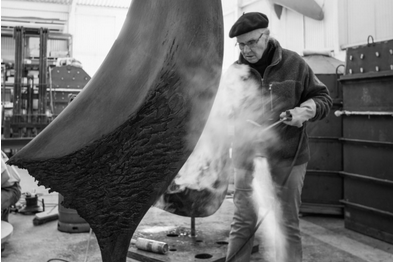
Bridget McCrum and Elisabeth Frink
Annette Ratuszniak
former curator, Elisabeth Frink Estate and Archive
Recently we came across a photograph by Eileen Agar taken in 1936 when she was in Brittany. The Bum-Thumb Rock image typifies Agar’s interest in the surrealist possibilities of natural objects, an absorption that she shared with Paul Nash during their entanglement.
The photograph reminded me of the stone carving by Bridget McCrum that Elisabeth Frink kept at Woolland, her Dorset home and workplace. McCrum’s sculpture was rediscovered among Frink’s plasters, studio materials and personal possessions in a warehouse where everything had languished for many years. The sculpture became informally known as Bridget McCrum’s ‘Bottom’ while its story was being unravelled.
The art and craft that Frink collected provides insights into her artistic interests and explorations. At first glance there seems little relationship between the stripped-down, modern classicism of McCrum’s stone carving and the semi-figurative expressionistic sculpture of Elisabeth Frink that was built in plaster and destined to be cast in bronze.
McCrum’s approach is reductive, removing mass from a block of stone using carving and sanding tools. She arrives at stylised shapes that play with light and weightlessness, as with her many birds which may be taking off, alighting or in flight.
Frink is often associated with sculpture that has jagged, emotive forms and rough surfaces. This is particularly evident in her early work, including her shape-shifting bird/beasts and birdmen that symbolise both aggression and vulnerability. But Frink was also absorbed in ideas of tranquillity, self-contained wholeness and human isolation, as she explained in 1954 when talking about her first Seated Man. In the 1960s she started to pare down her forms, arriving at broad, refined surfaces with shallow markings that play with the sweep of light. She added this approach to her repertoire as another way to reflect upon human actions and the consequences of global political upheavals.
McCrum, Frink, Agar: three women who each found ways to free themselves from the restraints of figurative precision. Their work is considered and suggests life through a shifting between shapes and images.